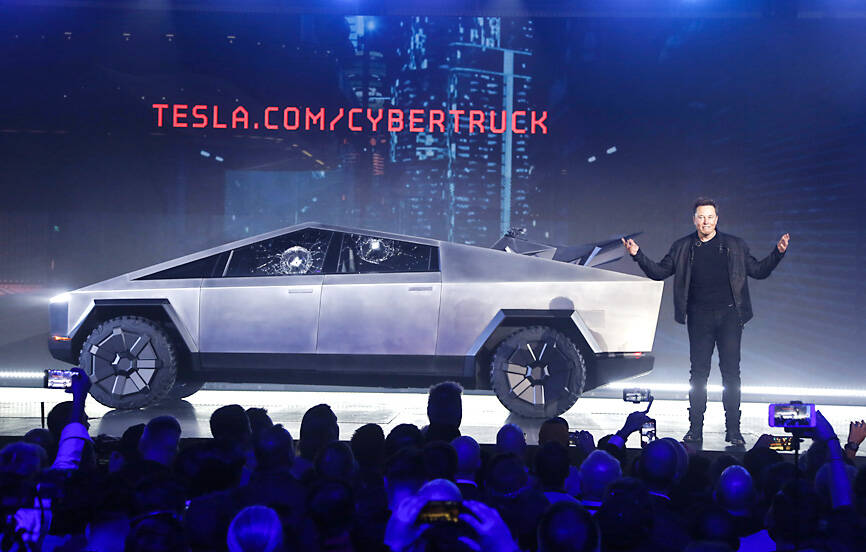Tesla’s long-delayed Cybertruck will have a starting price of US$60,990, more than 50 percent of what CEO Elon Musk had touted in 2019 and cost analysts have said would draw select, affluent buyers.
The truck, made of shiny stainless steel and shaped into flat planes, is partly inspired by a car-turned-submarine in the 1977 James Bond movie The Spy Who Loved Me, Musk has said.
Its new body material and unconventional, futuristic styling have added complexity and costs to production, and threaten to alienate traditional pickup truck buyers who focus on utility, experts said.

Photo: AP
However, Musk, who has priced the vehicle’s three variants between US$60,990 and US$99,990, on Thursday said that the Cybertruck has “more utility than a truck” and is “faster than a sports car.”
He drove a Cybertruck onto a stage to cheers from the crowd and later handed over vehicles to about a dozen customers at an event in Austin, Texas.
“Finally, the future will look like the future,” he said about the truck’s design, showing a video of the Cybertruck towing a Porsche 911 and beating another gasoline-powered 911 in a short race.
Musk did not announce the vehicle’s prices at the event, but Tesla’s Web site listed the prices. Its highest performance variant, the “Cyberbeast,” will be available next year, as will the all-wheel drive trim that starts at an estimated US$80,000.
The cheapest rear-wheel drive version with an estimated starting price of about US$61,000 will be available in 2025.
“This is going to appeal to ... definitely a wealthier clientele that can afford the price point and they want something that is unique and quirky,” said Jessica Caldwell, head of insights at auto research firm Edmunds.
“That just isn’t a large segment of the population that can afford that especially where interest rates are,” she said.
After Musk estimated in 2019 that the Cybertruck would sell for US$40,000, the vehicle drew more than 1 million reservation holders who put down US$100 deposits. He had not offered an updated price before Monday, despite rising raw material costs for electric vehicles (EV).
New deposits are US$250, Musk said on Thursday.
The price is not a surprise to many, said Paul Waatti, an analyst at consultancy AutoPacific.
Waatti told Reuters before the event that the Cybertruck would do well with a smaller audience.
Cybertruck, two years behind schedule, enters a hot pickup truck market to compete with the likes of Ford’s F150 Lightning, Rivian Automotive’s R1T and General Motors’ Hummer EV.
Rivian’s R1T has a starting price of US$73,000, while the F-150 Lightning starts at about US$50,000. The larger and more powerful Hummer EV pickup costs more than US$96,000.
The Cybertruck, Tesla’s first new model in nearly four years, is critical to its reputation as a maker of innovative vehicles. At a time when the company is battling softening EV demand and rising competition, Cybertruck is also key for generating sales, though not to the extent of the company’s high-volume Models 3 and Y.
Musk last month tempered investors’ expectations about the product, citing problems in ramping production and warning that it would take a year to 18 months to make it a significant cash flow contributor.

Intel Corp chief executive officer Lip-Bu Tan (陳立武) is expected to meet with Taiwanese suppliers next month in conjunction with the opening of the Computex Taipei trade show, supply chain sources said on Monday. The visit, the first for Tan to Taiwan since assuming his new post last month, would be aimed at enhancing Intel’s ties with suppliers in Taiwan as he attempts to help turn around the struggling US chipmaker, the sources said. Tan is to hold a banquet to celebrate Intel’s 40-year presence in Taiwan before Computex opens on May 20 and invite dozens of Taiwanese suppliers to exchange views

Application-specific integrated circuit designer Faraday Technology Corp (智原) yesterday said that although revenue this quarter would decline 30 percent from last quarter, it retained its full-year forecast of revenue growth of 100 percent. The company attributed the quarterly drop to a slowdown in customers’ production of chips using Faraday’s advanced packaging technology. The company is still confident about its revenue growth this year, given its strong “design-win” — or the projects it won to help customers design their chips, Faraday president Steve Wang (王國雍) told an online earnings conference. “The design-win this year is better than we expected. We believe we will win

Chizuko Kimura has become the first female sushi chef in the world to win a Michelin star, fulfilling a promise she made to her dying husband to continue his legacy. The 54-year-old Japanese chef regained the Michelin star her late husband, Shunei Kimura, won three years ago for their Sushi Shunei restaurant in Paris. For Shunei Kimura, the star was a dream come true. However, the joy was short-lived. He died from cancer just three months later in June 2022. He was 65. The following year, the restaurant in the heart of Montmartre lost its star rating. Chizuko Kimura insisted that the new star is still down

While China’s leaders use their economic and political might to fight US President Donald Trump’s trade war “to the end,” its army of social media soldiers are embarking on a more humorous campaign online. Trump’s tariff blitz has seen Washington and Beijing impose eye-watering duties on imports from the other, fanning a standoff between the economic superpowers that has sparked global recession fears and sent markets into a tailspin. Trump says his policy is a response to years of being “ripped off” by other countries and aims to bring manufacturing to the US, forcing companies to employ US workers. However, China’s online warriors